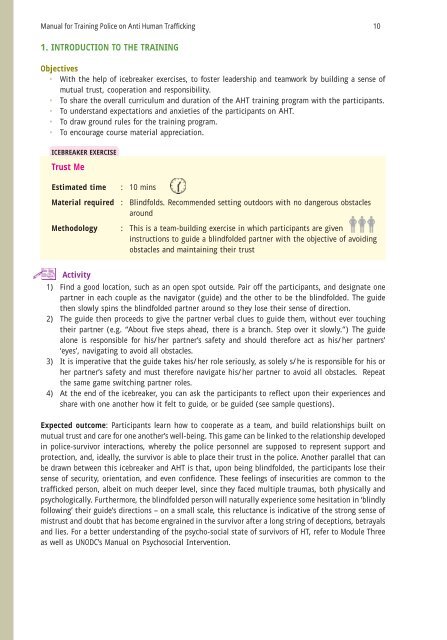Manual for Training Police on Anti Human Trafficking
Manual for Training Police on Anti Human Trafficking
Manual for Training Police on Anti Human Trafficking
Create successful ePaper yourself
Turn your PDF publications into a flip-book with our unique Google optimized e-Paper software.
<str<strong>on</strong>g>Manual</str<strong>on</strong>g> <str<strong>on</strong>g>for</str<strong>on</strong>g> <str<strong>on</strong>g>Training</str<strong>on</strong>g> <str<strong>on</strong>g>Police</str<strong>on</strong>g> <strong>on</strong> <strong>Anti</strong> <strong>Human</strong> <strong>Trafficking</strong> 10<br />
1. INTRODUCTION TO THE TRAINING<br />
Objectives<br />
With the help of icebreaker exercises, to foster leadership and teamwork by building a sense of<br />
mutual trust, cooperati<strong>on</strong> and resp<strong>on</strong>sibility.<br />
To share the overall curriculum and durati<strong>on</strong> of the AHT training program with the participants.<br />
To understand expectati<strong>on</strong>s and anxieties of the participants <strong>on</strong> AHT.<br />
To draw ground rules <str<strong>on</strong>g>for</str<strong>on</strong>g> the training program.<br />
To encourage course material appreciati<strong>on</strong>.<br />
ICEBREAKER EXERCISE<br />
Trust Me<br />
Estimated time : 10 mins<br />
Material required : Blindfolds. Recommended setting outdoors with no dangerous obstacles<br />
around<br />
Methodology : This is a team-building exercise in which participants are given<br />
instructi<strong>on</strong>s to guide a blindfolded partner with the objective of avoiding<br />
obstacles and maintaining their trust<br />
Activity<br />
1) Find a good locati<strong>on</strong>, such as an open spot outside. Pair off the participants, and designate <strong>on</strong>e<br />
partner in each couple as the navigator (guide) and the other to be the blindfolded. The guide<br />
then slowly spins the blindfolded partner around so they lose their sense of directi<strong>on</strong>.<br />
2) The guide then proceeds to give the partner verbal clues to guide them, without ever touching<br />
their partner (e.g. “About five steps ahead, there is a branch. Step over it slowly.”) The guide<br />
al<strong>on</strong>e is resp<strong>on</strong>sible <str<strong>on</strong>g>for</str<strong>on</strong>g> his/her partner’s safety and should there<str<strong>on</strong>g>for</str<strong>on</strong>g>e act as his/her partners’<br />
‘eyes’, navigating to avoid all obstacles.<br />
3) It is imperative that the guide takes his/her role seriously, as solely s/he is resp<strong>on</strong>sible <str<strong>on</strong>g>for</str<strong>on</strong>g> his or<br />
her partner’s safety and must there<str<strong>on</strong>g>for</str<strong>on</strong>g>e navigate his/her partner to avoid all obstacles. Repeat<br />
the same game switching partner roles.<br />
4) At the end of the icebreaker, you can ask the participants to reflect up<strong>on</strong> their experiences and<br />
share with <strong>on</strong>e another how it felt to guide, or be guided (see sample questi<strong>on</strong>s).<br />
Expected outcome: Participants learn how to cooperate as a team, and build relati<strong>on</strong>ships built <strong>on</strong><br />
mutual trust and care <str<strong>on</strong>g>for</str<strong>on</strong>g> <strong>on</strong>e another’s well-being. This game can be linked to the relati<strong>on</strong>ship developed<br />
in police-survivor interacti<strong>on</strong>s, whereby the police pers<strong>on</strong>nel are supposed to represent support and<br />
protecti<strong>on</strong>, and, ideally, the survivor is able to place their trust in the police. Another parallel that can<br />
be drawn between this icebreaker and AHT is that, up<strong>on</strong> being blindfolded, the participants lose their<br />
sense of security, orientati<strong>on</strong>, and even c<strong>on</strong>fidence. These feelings of insecurities are comm<strong>on</strong> to the<br />
trafficked pers<strong>on</strong>, albeit <strong>on</strong> much deeper level, since they faced multiple traumas, both physically and<br />
psychologically. Furthermore, the blindfolded pers<strong>on</strong> will naturally experience some hesitati<strong>on</strong> in ‘blindly<br />
following’ their guide’s directi<strong>on</strong>s – <strong>on</strong> a small scale, this reluctance is indicative of the str<strong>on</strong>g sense of<br />
mistrust and doubt that has become engrained in the survivor after a l<strong>on</strong>g string of decepti<strong>on</strong>s, betrayals<br />
and lies. For a better understanding of the psycho-social state of survivors of HT, refer to Module Three<br />
as well as UNODC’s <str<strong>on</strong>g>Manual</str<strong>on</strong>g> <strong>on</strong> Psychosocial Interventi<strong>on</strong>.

















